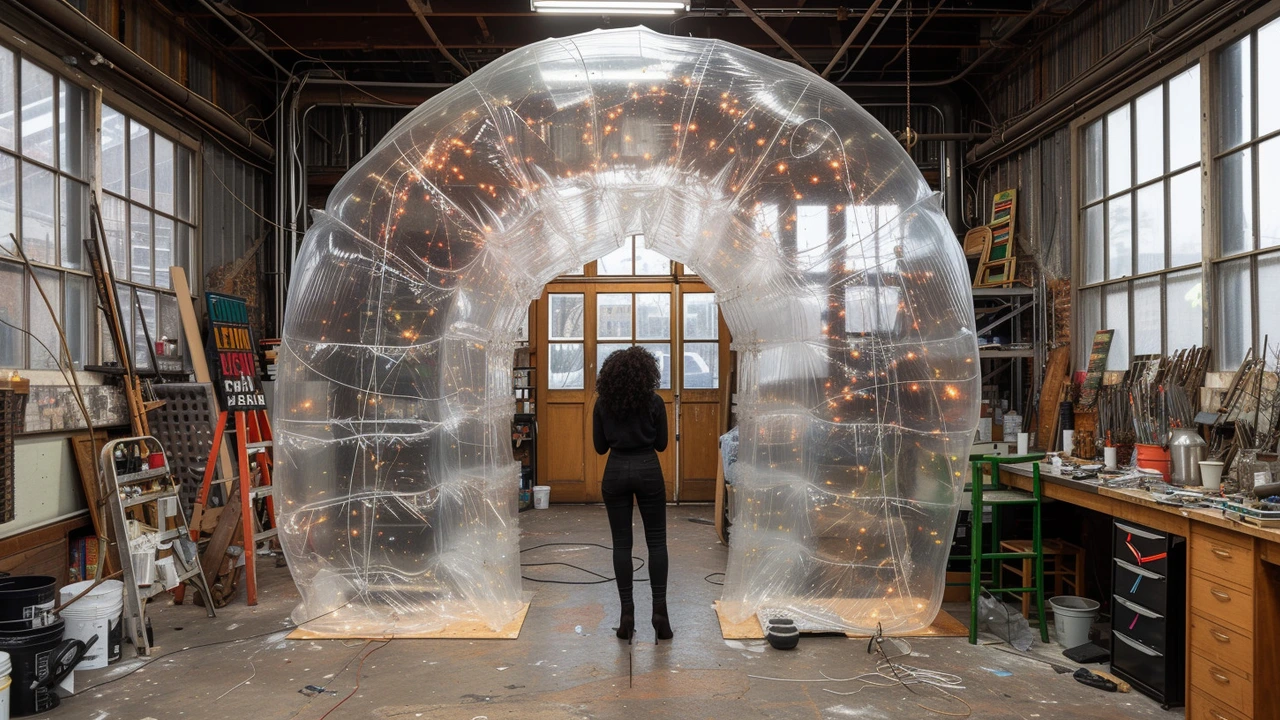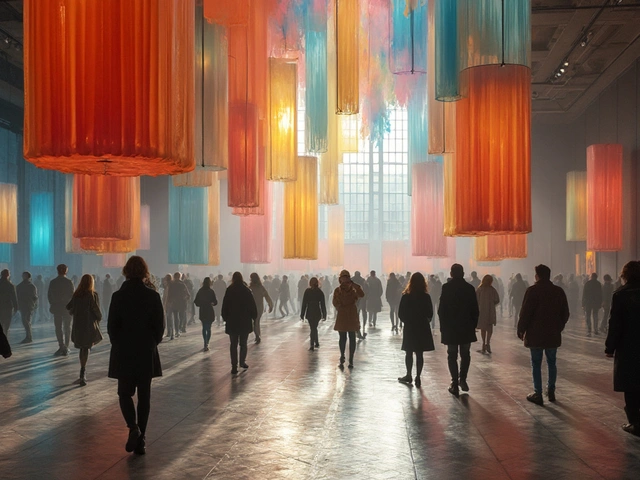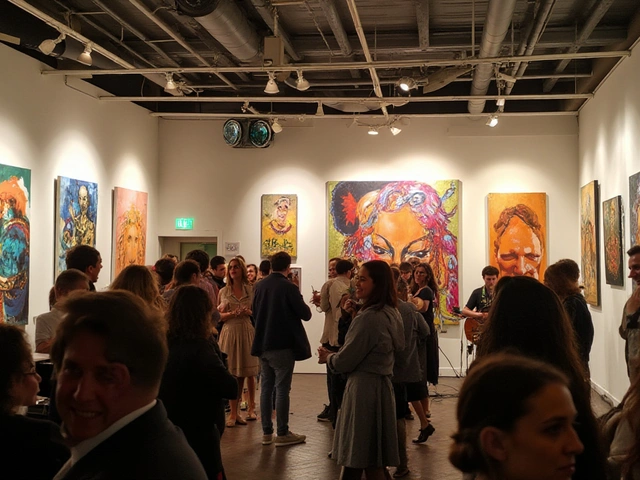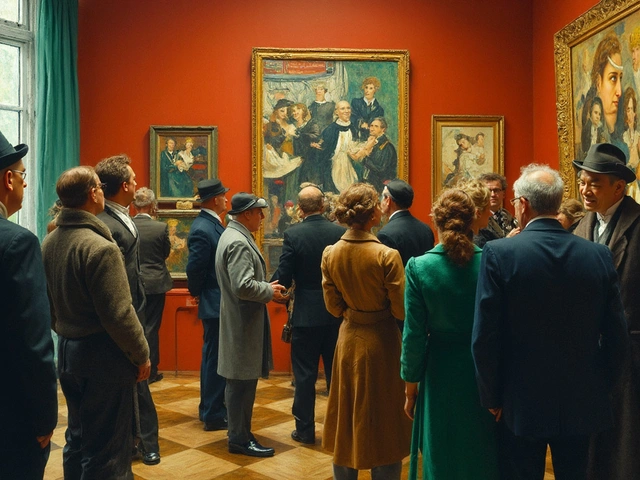Installation art is a fascinating blend of various artistic disciplines aimed at creating a three-dimensional experience for audiences. Unlike traditional art forms confined to a canvas or a stand, installation art immerses viewers within a given environment, offering them a chance to interact and connect on a personal level.
This contemporary art form is fundamentally about telling stories in a unique and engaging way. Artists often draw on themes ranging from social issues to personal narratives, using their installations to invite viewers into a shared space of contemplation and dialogue. This makes the process of experiencing installation art not just seeing, but feeling and interpreting.
With its origins in the 20th century, installation art has evolved to include digital media, sound, and even virtual reality, broadening the spectrum of sensory engagement. Artists like Yayoi Kusama and Ai Weiwei have pushed the boundaries of this medium, turning simple spaces into powerful statements that resonate deeply.
If you are new to the world of installation art, here’s a tip: approach each piece with an open mind. Allow yourself to be enveloped by the environment crafted by the artist. Pay attention to the details and try to uncover the narrative within. This immersive approach can often lead to a more profound appreciation and understanding of the work.
- The Essence of Installation Art
- How Installation Art Tells a Story
- Notable Installation Artists and Works
- Tips for Experiencing Installation Art
How Installation Art Tells a Story
Installation art transforms traditional storytelling by creating an immersive experience that engages multiple senses. Unlike conventional art forms, where the audience is a passive observer, installation art places the viewer in the center of the narrative. This interaction allows for a more personal and emotional connection to the story being told.
An artist often starts with a concept or theme. They use the space provided to them, carefully planning each element to contribute to the overall message. Lighting, sound, textures, and even the physical arrangement of objects come together to evoke specific emotions and thoughts. For instance, an artist might use dim, flickering lights and eerie soundscapes to instill a sense of fear or unease, aligning perfectly with a story of loss or desolation.
Immersive Experiences
By immersing viewers in a particular environment, installation art can create a powerful narrative. An example is the work of Yayoi Kusama, whose installations often feature repetitive patterns and mirrored surfaces. In her famous “Infinity Mirror Rooms,” the viewer is enveloped in a seemingly endless space, evoking feelings of both isolation and connection. This duality is central to Kusama's storytelling, reflecting her personal experiences and struggles.
“I want to create a world, a world of unbounded, infinite beauty. That’s how I see it,” said Yayoi Kusama.
Moreover, installation art can also be deeply interactive, encouraging audience participation. Olafur Eliasson’s “Weather Project,” displayed at the Tate Modern in London, is a prime example. Eliasson created a massive, glowing sun, with mirrors on the ceiling amplifying the effect. Visitors could lay on the floor, bask in the artificial sunlight, and see themselves reflected above. This installation invited viewers to ponder their place in the ecosystem, blending personal reflection with a broader environmental narrative.
Historical and Social Narratives
Installation art is not limited to personal or abstract themes; it can also depict historical events and social issues. Ai Weiwei’s “Sunflower Seeds,” displayed at Tate Modern, consisted of over 100 million porcelain seeds, hand-painted by artisans. Each seed represented individuality, yet collectively, they conveyed themes of mass production, consumerism, and the loss of individuality in modern society. This installation was a powerful commentary on Chinese history and culture, demonstrating how art can serve as a medium for social reflection.
Similarly, Kara Walker’s “A Subtlety or the Marvelous Sugar Baby” tackled issues of race and exploitation. Her installation featured a massive sugar-coated sphinx-like figure, surrounded by smaller figures made of molasses. These elements combined to tell a complex story about the history of slavery and the exploitation of African Americans in the sugar industry. Walker’s work used the physical properties of the materials to symbolize and convey deeper meanings, adding texture to her narrative.
Utilizing Technology
With the advent of new technology, the scope of installation art has expanded significantly. Digital installations often incorporate virtual or augmented reality, creating stories that blend the physical and digital worlds. Rafael Lozano-Hemmer’s “Pulse Room” is an interesting example. The installation features hundreds of light bulbs that flash in response to the viewer’s heartbeat, creating a visually stunning and deeply personal narrative experience. By integrating biofeedback technology, Lozano-Hemmer highlights the connection between human life and light, crafting a narrative that’s both intimate and universal.
James Turrell’s “Skyspaces” use natural light, changing throughout the day, to alter the viewer’s perception of space and time. These installations often feature a simple room with an opening to the sky, and as the light changes, so does the viewer's experience. The interplay of light and space tells a story about our relationship with the natural world, inviting viewers to slow down and contemplate their surroundings.
Installation art’s beauty lies in its ability to engage the senses and provoke deep reflection. By transforming space into a storytelling medium, artists can convey complex narratives that resonate on multiple levels, creating a lasting impact on those who experience their work.
Notable Installation Artists and Works
Installation art has been significantly shaped and enriched by the contributions of visionary artists who have pushed the limits of this medium. Let's start with the iconic Yayoi Kusama, renowned for her immersive rooms filled with mirrors and lights. One of her most famous works, Infinity Mirrored Room, invites viewers into an endless field of lights and reflections, evoking a sense of the infinite. Kusama's installations often explore themes of infinity and self-obliteration, making her a pivotal figure in contemporary art. An interesting fact is that Kusama's obsession with dots, visible in her works, stems from her own hallucinations, which she has been experiencing since childhood.
Another influential name is Ai Weiwei, a Chinese artist and activist known for his politically charged works. His installation piece, Sunflower Seeds, displayed at the Tate Modern in London, featured over 100 million handcrafted porcelain seeds, symbolizing the power of collective effort and the loss of individuality in mass production. Ai Weiwei's works often challenge viewers to reflect on social and political issues, making them more than just artistic expressions.
Next on the list is Olafur Eliasson, who masterfully blends art and nature. His famous piece, The Weather Project, exhibited at the Tate Modern's Turbine Hall, used a massive sun-like disk to transform the space into an eerily beautiful and otherworldly environment. By using light, mirrors, and mist, Eliasson creates immersive experiences that encourage viewers to reconnect with nature and question their perceptions of reality. His philosophy emphasizes the importance of viewer engagement, as he once said:
"Art is not all about intellectual understanding; it’s also about the feeling and the senses."
We can’t overlook Kara Walker, whose monumental installation A Subtlety, or the Marvelous Sugar Baby at the Domino Sugar Factory in Brooklyn, captivated the world with its stark examination of slavery, race, and industrial exploitation. The massive sugar-coated sculpture of a sphinx-like woman symbolized the brutal history of sugar production and the African slaves who suffered in its process. Walker's use of installation art to confront uncomfortable historical truths has made her an essential figure in the art world.
Another prominent name is James Turrell who has been exploring the relationship between light and space for decades. His work, Roden Crater, is a monumental project transforming a natural cinder volcano in Arizona into a celestial observatory. This ongoing work invites viewers to experience the changing light of the sky in a profound and meditative way. Turrell’s installations are often described as spiritual, providing a space for quiet contemplation and a deeper connection to the cosmos.
Tips for Experiencing Installation Art
Experiencing installation art can sometimes feel overwhelming due to its immersive and often complex nature. However, these tips will help you navigate and fully appreciate this captivating art form. First and foremost, approach the installation with an open mind. Forget about preconceived notions of what art should look like and allow yourself to be fully present in the moment. Installation art often uses unexpected materials and unconventional arrangements, which can be disorienting at first but are always worth exploring.
Take your time. Installation art is meant to be experienced slowly. Walk through the space, observe the details, and notice how the different elements interact with each other. Pay attention to the use of light, sound, and texture. Each component is intentionally placed and contributes to the overall narrative the artist wants to convey. By taking your time, you will start to see the connections and understand the story being told.
Engage with all your senses. Many installation art pieces are multisensory, incorporating sound, touch, and sometimes even smell. Don’t just rely on your sight; listen to the sounds, feel the textures, and immerse yourself completely in the environment. This full sensory engagement can lead to a deeper understanding and appreciation of the artwork.
Read any provided information. Artists often include text panels, brochures, or even digital guides that explain their work. Don’t skip these! They can provide valuable context and insight into the artist’s intentions and the themes they are exploring. These materials can sometimes transform your understanding of the piece from confusion to clarity.
If available, take part in guided tours or attend talks by the artist. These events can offer a direct line to the artist’s thought process and provide behind-the-scenes information about the creation of the piece. Hearing the artist speak about their work can be incredibly enriching and give you a new perspective on the installation.
Reflect on your feelings and thoughts. Installation art is designed to evoke emotions and provoke thought. After experiencing the installation, take some time to reflect on how it made you feel and what thoughts it brought up. Write down your impressions and revisit them later. This reflective practice can enhance your overall experience and deepen your connection to the artwork.
Photograph responsibly. While it is often tempting to take photos for social media, be mindful of the rules set by the artist or gallery. Some installations are meant to be experienced in a specific way that photography can disrupt. If photos are allowed, make sure to capture the essence of the installation without detracting from the experience of others.
Lastly, talk to others. Discussing the piece with friends or other attendees can open up new interpretations and insights. Everyone brings their own perspective and background to an installation, and hearing different viewpoints can enrich your understanding. You might discover aspects of the artwork you hadn’t noticed before through these conversations.




